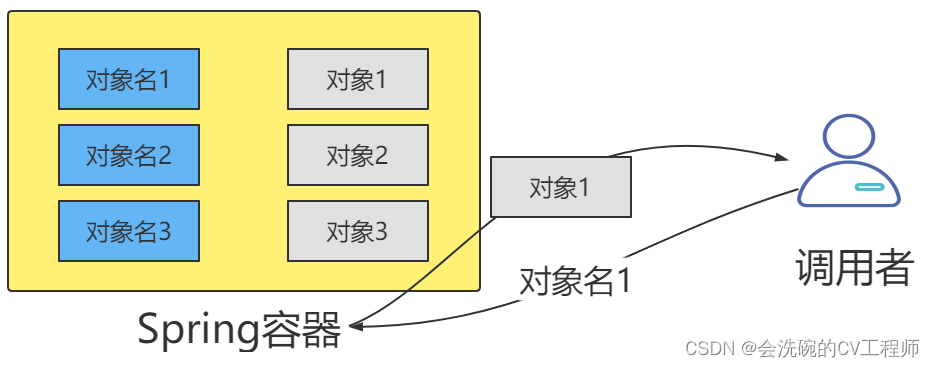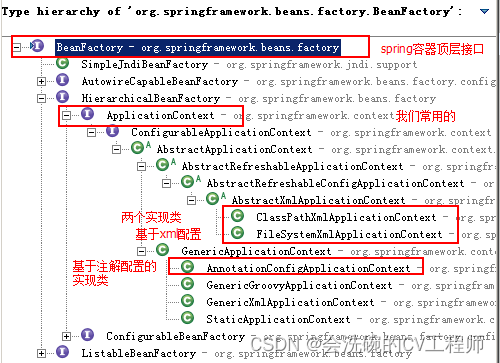目录
一、相关导读
大家如果对于本期内容有什么不了解的话也可以去看看往期的内容,下面列出了博主往期精心制作的Maven,Mybatis等专栏系列文章,走过路过不要错过哎!如果对您有所帮助的话就点点赞,收藏一下啪。其中Spring专栏有些正在更,所以无法查看,但是当博主全部更完之后就可以看啦。
1. Maven系列专栏文章
2. Mybatis系列专栏文章
3. Spring系列专栏文章
二、前言
Spring简介
Spring是一个开源框架,为简化企业级开发而生。它以IOC(控制反转)和AOP(面向切面)为思想内核,提供了控制层SpringMVC、数据层SpringData、服务层事务管理等众多技术,并可以整合众多第三方框架。Spring将很多复杂的代码变得优雅简洁,有效的降低代码的耦合度,极大的方便项目的后期维护、升级和扩展。
Spring官网地址:Spring | HomeSpring官方网站:
Spring体系结构
Spring框架根据不同的功能被划分成了多个模块,这些模块可以满足一切企业级应用开发的需求,在开发过程中可以根据需求有选择性地使用所需要的模块。
- Core Container:Spring核心模块,任何功能的使用都离不开该模块,是其他模块建立的基础。
- Data Access/Integration:该模块提供了数据持久化的相应功能。
- Web:该模块提供了web开发的相应功能。
- AOP:提供了面向切面编程实现
- Aspects:提供与AspectJ框架的集成,该框架是一个面向切面编程框架。
- Instrumentation:提供了类工具的支持和类加载器的实现,可以在特定的应用服务器中使用。
- Messaging:为Spring框架集成一些基础的报文传送应用
- Test:提供与测试框架的集成
三、Spring实现IOC

接下来我们使用Spring实现IOC,Spring内部也有一个容器用来管理对象。
1. 创建Maven工程,引入对应依赖
org.springframework spring-context 5.3.13 junit junit 4.12 test 2. 创建实体类,Dao接口及实现类
Student实体类
package com.example.pojo;public class Student { private int id; private String name; private String address; public Student(int id, String name, String address) { this.id = id; this.name = name; this.address = address; } public Student(){} public int getId() { return id; } public void setId(int id) { this.id = id; } public String getName() { return name; } public void setName(String name) { this.name = name; } public String getAddress() { return address; } public void setAddress(String address) { this.address = address; } @Override public String toString() { return "Student[ " + "id=" + id + ", name='" + name + '\'' + ", address='" + address + '\'' + " ]"; }}StudentDao接口
package com.example.dao;import com.example.pojo.Student;public interface StudentDao { // 根据id查询学生 Student findById(int id);}StudentDao接口实现类StudentDaoImpl1
package com.example.dao;import com.example.pojo.Student;public class StudentDaoImpl1 implements StudentDao{ public StudentDaoImpl1() { } public StudentDaoImpl1(int a){}; @Override public Student findById(int id){ return new Student(id,"程序员","北京"); }}3. 编写xml配置文件
4. 测试从Spring容器获取对象
package com.example;import com.example.dao.StudentDao;import com.example.service.StudentService;import org.junit.Test;import org.springframework.context.ApplicationContext;import org.springframework.context.support.ClassPathXmlApplicationContext;import org.springframework.context.support.FileSystemXmlApplicationContext;public class TestContainer { @Test public void t1(){ // 创建Spring容器 ApplicationContext ac = new ClassPathXmlApplicationContext("bean.xml"); // 从容器中获取对象 StudentDao studentDao1 = ac.getBean("studentDao",StudentDao.class); StudentDao studentDao2 = ac.getBean("studentDao",StudentDao.class); System.out.println(studentDao1.hashCode()); System.out.println(studentDao2.hashCode()); System.out.println(studentDao1.findById(1)); }}5. 测试结果

OK,同样返回两个对象的哈希值都是一样的,说明了确实是从容器中获取同一个对象。
四、Spring容器类型

1. 容器接口
- BeanFactory:BeanFactory是Spring容器中的顶层接口,它可以对Bean对象进行管理。
- ApplicationContext:ApplicationContext是BeanFactory的子接口。它除了继承 BeanFactory的所有功能外,还添加了对国际化、资源访问、事件传播等方面的良好支持。ApplicationContext有以下三个常用实现类:
2. ApplicationContext容器实现类
- ClassPathXmlApplicationContext:该类可以从项目中读取配置文件
- FileSystemXmlApplicationContext:该类从磁盘中读取配置文件
- AnnotationConfigApplicationContext:使用该类不读取配置文件,而是会读取注解
3. 测试从磁盘读取配置文件
@Test public void t2(){ // 创建spring容器 ApplicationContext ac = new FileSystemXmlApplicationContext("C:\\JavaProjects\\06SSM_Projects\\springdemo\\spring_ioc1\\src\\main\\resources\\bean.xml"); // 从容器中获取对象 StudentDao userDao = ac.getBean("studentDao",StudentDao.class); System.out.println(userDao); System.out.println(userDao.findById(1));; }4. 测试结果

OK,本次使用Spring实现IOC就到这里了,上述讲到的三个实现类会在接下来中多次使用,希望对大家有所帮助
来源地址:https://blog.csdn.net/qq_53317005/article/details/129780496




